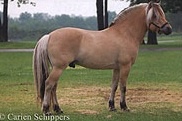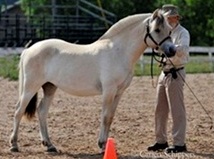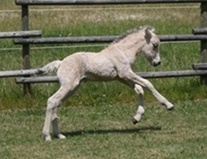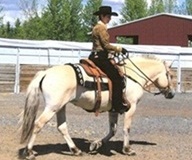Breed Standard
The Fjord Horse
Reproduced from the FHI websiteBackground and distribution
 The Fjordhorse, one of Norway's three native breeds, is also one of the world's oldest and purest breeds. Breeding took place mainly in the west of Norway so that the breed was also known as "Vestlandshesten" (the horse of the western country).
The Fjordhorse, one of Norway's three native breeds, is also one of the world's oldest and purest breeds. Breeding took place mainly in the west of Norway so that the breed was also known as "Vestlandshesten" (the horse of the western country).
Little is known about the origin of the breed. There are many similarities such as colour and primitive markings between the feral Przewalski horse and the Fjord. The Fjord is rather like the European wild horse, the Tarpan, now extinct in its natural state. However, the Fjord Horse does not descend from the Przewalski Horse, as the Przewalski has 66 chromosomes, and the Fjord and Tarpan 64.
It is most likely that the horse came to Norway from the east. There seem to have been wild horses in the south of Sweden and in Denmark since the last ice age. Archaeological excavations reveal that the horse was domesticated in the Bronze Age, circa 1200 BC. Viking burial grounds show that man had bred the horse for about 2000 years and it appears that the Fjord Horse is a descendant of the earliest horses in Norway. Through the ages there has been a great deal of contact between Norway, Iceland and the British Isles, and horses from these lands across the sea have surely influenced the development of the breed.
Today the Fjord is to be found throughout Norway, but the majority is bred in the West. There is a widespread interest in the breed and a considerable number of Fjords are bred both in Europe and in the USA and Canada. According to the conference of Rio and the EU regulations for animal breeding, Norway is the "Mother country of the Fjord Horse." Regarding to this fact Norges Fjordhestlag and Norsk Hestesenter strengthened their responsibility for the breed and started specific international promotion of the Fjord Horse.
Characteristics
Description of the Fjord Horse
 The general appearance of the Fjord Horse shall be strongly built, hardy, well-proportioned and athletic, a horse with great presence and charm. The horse shall be co-operative, dependable, willing, and calm in most situations and have natural, well-balanced movements. The Fjord shall be a versatile riding, driving and draught horse. The conformation of the Fjord should assure that he moves equally well in difficult terrain as on the flat.
The general appearance of the Fjord Horse shall be strongly built, hardy, well-proportioned and athletic, a horse with great presence and charm. The horse shall be co-operative, dependable, willing, and calm in most situations and have natural, well-balanced movements. The Fjord shall be a versatile riding, driving and draught horse. The conformation of the Fjord should assure that he moves equally well in difficult terrain as on the flat.
With these qualities the Fjord Horse should be easy to handle and suitable for family use, and in different activities as in riding schools, competitions and for leisure.
Height
There is no upper or lower limit, but the desired height at the withers is between 135 cm and 150 cm (13.1 – 14.3 Hands).
Colours and markings
The five accepted colours are brown dun, white dun, grey (blue dun), red dun and yellow dun. It is important that the so-called primitive markings are appreciated and preserved. A star is only accepted on a mare. Other visible markings are not accepted
Hair
The forelock on mature horses covers from one half to two thirds of the head. Excessive feathering on the legs is not desirable. Tradition rules that the Fjord should have an upright mane. The horse ought be presented with a clipped mane in a convex shape to complement the neck’s top line.
The head
 It is important when assessing breed type and character. It should be proportional, small and well defined, with a wide and flat forehead. The length from the eye to the muzzle should be short; the profile should be straight or preferably slightly dished (concave). The eyes should be large, dark and bright with a calm expression. The nostrils ought to be wide and in proportion so that the muzzle gives a "square" appearance. The jaws should be well defined. The lower jaws must not be so heavy as to make the head appear coarse. There should be sufficient width between the jaws to ensure free movement of the head or flexion of the poll. The ears should be relatively short, with a refined point at the tips and wide set. The ears should be parallel, with an outward curvature from the tip to the middle of the ear. Long pointed ears that are close together and in constant movement are not typical of the Fjord Horse.
It is important when assessing breed type and character. It should be proportional, small and well defined, with a wide and flat forehead. The length from the eye to the muzzle should be short; the profile should be straight or preferably slightly dished (concave). The eyes should be large, dark and bright with a calm expression. The nostrils ought to be wide and in proportion so that the muzzle gives a "square" appearance. The jaws should be well defined. The lower jaws must not be so heavy as to make the head appear coarse. There should be sufficient width between the jaws to ensure free movement of the head or flexion of the poll. The ears should be relatively short, with a refined point at the tips and wide set. The ears should be parallel, with an outward curvature from the tip to the middle of the ear. Long pointed ears that are close together and in constant movement are not typical of the Fjord Horse.
Conformation/structure and muscular development
It is important that the body parts are in harmony. Variations in the breed may be accepted, but the Fjord Horse should have good depth through the heart girth and width through the barrel and a proportional amount of muscling reflecting gender and age.
The neck
Ought to be set high and have a convex top line. Stallions especially often have a strong neck. The Fjord for a period of time was used for heavy work, so a short, strong neck and straight shoulder was seen as an asset and favoured. Today a longer and suppler neck is desired, being more suitable for riding, driving and as a packhorse. Length at the poll and a smooth transition from the head to the neck is desired. It must be recognized that a long, thin neck is not desirable.
Shoulder and withers
The shoulder region influences significantly the movement of the horse; hence today it is desirable to have a gently sloping shoulder angle, which allows forward extension of the forelimbs. (A straight shoulder was wanted when the Fjord was used for heavy work). The withers of the Fjord Horse are not typically prominent but blend smoothly into the back.
The withers should be sufficiently well defined so as to be a good anchor point for the shoulder- and back muscles. The forehand should have the same length as the back and hindquarters
Body and top line
The ribs should be well sprung, yet not round. The back and the loin area should be smooth and well-muscled. The loins are extremely important and should be carefully assessed, as they are the bridge between the mid-section and the hindquarters. The transition between the loin and croup should be flexible and blend smoothly together. The length of the coupling/loin should be short, yet strong and proportional to the back and the croup.
The Hindquarters
The croup should be long, broad, well-muscled and sloping. Too sloping or too flat are not desirable. The tail should not be set on too high or too low and it should be carried freely and naturally. The thighs should be sufficiently long, well-muscled seen both from the side and from behind, and should be set as wide as the quarters.
Legs
 The forearm should be broad and well muscled. In the hind legs the thigh and gaskin muscling should be long and well developed seen both from the side and from behind. Too long a gaskin is considered a drawback for a draught horse. The legs should be correctly aligned and with adequate bone. The joints and tendons must be clearly defined and dry. A short and firm cannon bone is desired. The cannon bones ought to be clean and dry, and should not be tied below the knee. The knee (carpal joint) should be large, and well defined. The hock joint should be large, well developed and dry. Small ill-defined hocks are not suitable for the breed. The point of the hock must be prominent when viewed from the side. Too straight or bowed hocks are objectionable.
The forearm should be broad and well muscled. In the hind legs the thigh and gaskin muscling should be long and well developed seen both from the side and from behind. Too long a gaskin is considered a drawback for a draught horse. The legs should be correctly aligned and with adequate bone. The joints and tendons must be clearly defined and dry. A short and firm cannon bone is desired. The cannon bones ought to be clean and dry, and should not be tied below the knee. The knee (carpal joint) should be large, and well defined. The hock joint should be large, well developed and dry. Small ill-defined hocks are not suitable for the breed. The point of the hock must be prominent when viewed from the side. Too straight or bowed hocks are objectionable.
The fetlock joints should be strong and well defined. The pasterns should be strong, and sufficiently long and sloping to give adequate support and elasticity. The hooves of the Fjord Horse should be well balanced and proportionately round and large, with good horn quality, the inside of the hoof wall may be slightly steeper than the outside. Good sound hooves are extremely important for the horse.
The movements
are particularly important for the horse, and must reflect the conformation in sufficient elasticity and impulsion to perform an effortless walk, trot and canter. The movements should be energetic, with good balance and cadence. The Fjord Horse must move freely in all three gaits. The canter should be balanced, and free with supple and elastic forward movement. The trot shall be energetic, however excessive action is considered not typical for the breed.
Gender characteristics
The Fjord Horse should have distinct gender characteristics; the stallion should be masculine and the mare feminine.
Uses of the Fjordhorse
 The Fjord is easy to feed, strong, tough but docile, with a capacity for working long hours, day after day under difficult conditions. This together with its versatility made the Fjord Horse very suitable for work on the small farms in the West Country long before mechanization began.
The Fjord is easy to feed, strong, tough but docile, with a capacity for working long hours, day after day under difficult conditions. This together with its versatility made the Fjord Horse very suitable for work on the small farms in the West Country long before mechanization began.
Versatility is a key word when describing the Fjordhorse. Traditionally the Fjord has been used on the farm, moving timber as well as being used as a packhorse, or pulling the flight or the farm wagon. His good temperament, sure footedness and adaptability are a great advantage in the rugged country of the West. Many farmers also hired out their horses to tourists and the local priest or the doctor drove with their two-wheel carriage pulled by a Fjord Horse to their duties around the parish.
In later years, the Fjord became a popular leisure and family horse. The Fjord of today is bred for both riding and driving and is capable of performing well in driving and endurance riding and can also perform adequately in elementary dressage and cross-country jumping classes. The Fjord is used extensively in riding schools and riding for the disabled.
The tourist industry along the West Country fjords of Norway has always used the Fjordhorse as an important means of transport and as a good representative for Norwegian culture with a today status of a national symbol. So the Fjordhorse was also represented in the Winter Olympics at Lillehammer in 1994 and with the two other Norwegian native breeds, the Døle horse and the Northlands horse safely drove many winning competitors and celebrities to the different activities. During the summers the Fjordhorse was and is carrying and driving many tourists back and forth to waterfalls and glaciers.
Breeding and studbookkeeping
Shows are an important aspect of breeding and are arranged throughout the country by the Norwegian Horse Centre (NHS). Both conformation and performance are judged.
The original system in Norway is based on the evaluation of individuals for breeding purposes i.e. against the breed standard, not necessarily against the other individuals in a class. All animals are graded; both mares and stallions, and all are performance tested.
The highlight of the year for Fjordhorse enthusiasts is the Stallion Show at Nordfjordeid at the beginning of May. Buyers and enthusiasts from home and abroad come to see the Fjord in his natural environment.
All breeding is based on the current breeding plan for the Fjordhorse, adopted by the NHS. The aims stated in the breeding goal are to preserve and improve the breed’s original character and type as well as to satisfy the needs of today which is a versatile animal suitable for the whole family.



 Daventry Web Design
Daventry Web Design